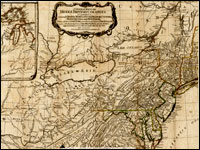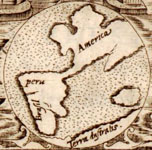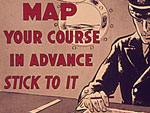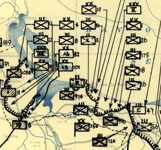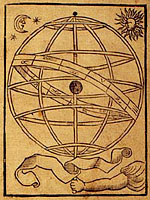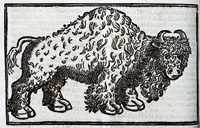The period during which Frémont's chart appeared was one of rapid industrialization and urbanization in the Northeastern states. Economic historian Douglass C. North has identified the 1840s and early 1850s as the era in which "the pace of industrialization accelerated to the degree that the Northeast could unequivocally be called a manufacturing region."
In 1850, urban population in the Northeast accounted for 27 percent of the total population, while the South was only eight percent urban. During the next decade, the South remained predominately rural, with 10 percent of its population living in cities or towns in 1860, while the Northeast continued to urbanize at a swift pace, with an urban population that had grown to 36 percent. Despite the region's growth in industry and urban population, the Northeast retained a large rural population: 73 percent of its total population in 1850 and 64 percent in 1860. Yet, the size of the rural Northeastern population accounts only for part of the answer to the apparent contradiction stated in the question. The seeming paradox can be only resolved if we start by noting the exact language that was used in Frémont's chart.
Fremont's Language
The chart explicitly referred to "free states," not states in the North or Northeast. During this period, the number of farms in the developing area that we now call the Midwest—which with the exception of Missouri was composed solely of free state—increased at a faster pace than in any other region of the nation due to the increasing ability of persons of modest means to purchase newly available, relatively small plots of public land. These new farms tended more and more to be oriented to the market rather than to self-sufficiency. The concurrent rise in urban population in the Northeast was closely related to the growth of agriculture as a commercial enterprise in the Midwest. As cities grew, so did a demand for food that Midwestern farmers supplied. A closer look at the statistics and at the analyses of agricultural and economic historians will help make further sense of the situation.
The number of farms listed on Frémont's chart was derived from the 1850 census (with one small discrepancy—while the chart lists 873,678 farms in free states, the total calculated from the census actually comes to 873,608). According to census figures, New England states (Maine, Vermont, New Hampshire, Massachusetts, Rhode Island, and Connecticut) accounted for 19 percent of the farms in free states, or 167,651 farms; Middle Atlantic free states (New York, Pennsylvania, and New Jersey) totaled 37 percent or 322,103 farms; and the Midwestern free states (Ohio, Indiana, Illinois, Michigan, Wisconsin, and Iowa) 44 percent or 382,982. (The census listed only 872 farms in California, the only state in the far west that had been admitted to the Union by that time.) New York led the free states in number of farms with 170,621. Ohio, the first Midwestern state to be settled, came in second with 143,807. Pennsylvania followed with 127,577, Indiana had 93,896, and Illinois 76,208. In the slave states, Virginia had the most farms with 77,013, followed by Kentucky with 74,777, Tennessee with 72,735, North Carolina with 56,963, Missouri with 54,458, and Georgia with 51,759.
The Business of Agriculture
During the decade of the 1850s, the total number of farms in the U.S. increased by 41 percent, from 1,442,908 to 2,030,785 farms. Nearly half of the new farms were located in the free states of the Midwest. In his classic work of U.S. agricultural history, The Farmer's Age: Agriculture, 18151860, Paul W. Gates stated that the "rush for the public domain" during the 1850s "surpassed anything in previous history." Gates attributed the rise in land sales to lower prices and to "[f]rantic railroad building, particularly in the upper Mississippi Valley; the great influx of Germans, Scandinavians, and Easterners into the West; and a new era of banking experiments which greatly increased available credit." Historians have identified this period as part of an "agricultural revolution" that eventually led to the passage of the Homestead Act of 1862, through which homesteading settlers could obtain 160 acres of public land free of charge.
The revolution, which encouraged land speculators in addition to settlers, marked a major shift in agricultural practice in the free states, as "by the 1850s, market-oriented agriculture was firmly established as the dominant approach, clearly distinguishable from the semisubsistence approach," according to agricultural historian Clarence H. Danhof. Economic historian Harold D. Woodman has characterized the "large class of property owners on western lands" during this period as consisting "neither of peasant proprietors nor of yeoman farmers but, rather, of businessmen on the make."
Land Sales
Two visions of the nation's future had dominated early legislative initiatives regarding land sales from the federal government, which under the Articles of Confederation had acquired all state-owned lands west of the Appalachians. Alexander Hamilton and his Federalist followers believed that prices for public land should be set at high levels both to benefit the U.S. treasury and to discourage agriculture in favor of manufacturing endeavors. In contrast, Thomas Jefferson and like-minded politicians, who envisioned a republic of yeoman family farmers, sought low prices for small lots of land that could be purchased on credit by people of average means.
Federalist policy prevailed in early land sales legislation; in 1790, the minimum cost for land purchased from the government was set at $1,280 and the minimum amount sold was set at 640 acres. Due to poor sales, later legislation gradually relaxed maximum and minimum terms, so that by 1820, the minimum price of an acre had dropped from a high of $2 to $1.25 and the minimum amount that could be sold was lowered to 80 acres. In 1832, this amount was reduced further to 40 acres, and by 1854, the minimum price for public land that had remained unsold for more than 30 years was lowered drastically to 12 ½ cents per acre.
The federal government sold nearly 50 million acres between 1850 and 1859. In free states, the number of farms increased by 44 percent to 1,255,518 farms, while those in the slave states increased by 36 percent to 775,267. Midwestern states experienced the highest growth rate in numbers of farms among all regions of the nation. Between 1850 and 1860, the number of farms in the New England states increased by 10 percent, with 16,291 new farms bringing the total to 183,942. Middle Atlantic states increased its number of farms by 18 percent with an additional 58,890 to total 380,993 farms.
Midwestern states (including Minnesota, which had become a state in 1858) increased their number of farms by 74 percent with an additional 283,079 farms to total 666,061, or 53 percent of free state farms. New York, Ohio, and Pennsylvania remained the states with the largest number of farms in the free states (196,990, 179,889, and 156,357, respectively), while Illinois had jumped to fourth place with 143,310 and Indiana increased to 131,826.
The far western states of California and Oregon (admitted to the Union in 1859) with 24,522 farms, accounted for 2 percent of the total number of farms in the free states. The number of farms in southern states in which public lands were sold increased dramatically: by 26 percent in Mississippi, 29 percent in Louisiana, 31 percent in Alabama, 53 percent in Florida, 70 percent in Missouri, 120 percent in Arkansas, and 252 percent in Texas. While the number of farms in the South grew at a greater rate than that of the Northeast, they increased by less than half the rate of Midwestern farms.
Size and Numbers
While the number of farms in the South was less than that of the Northeast and the Midwest combined, the size of farms in slave states was greater on average than those in free states. In 1850, the average-sized farm in the slave states was 318 acres; in the free states, the average size was 128 acres, or 40 percent of the size of an averaged-sized farm in the South. The average size of farms in both free and slave states remained near constant from 1850 to 1860. According to the 1860 census, an average-sized farm in the free states in 1860 was 125 acres, or 3 acres smaller than in 1850, while in the slave states the average acreage had increased from 318 to 319.
Frémont's Midwestern supporters, who put together the chart, were part of a growing movement of farmers who "broke politically with southern planters in the 1850s," according to agriculture and economics professor Willard W. Cochrane. These farmers, Cochrane has written, "came to resist the extension of slavery and the plantation system out of fear of competition from large plantation units based on slave labor with their small family-sized units." In order to survive during the transition to market-oriented farming, they allied themselves more with economic interests in the Northeast than with planters in the South. "The stage was thus set for the realignment of political power, the founding of the Republican party, and the eventual War between the States," Cochrane concluded.
